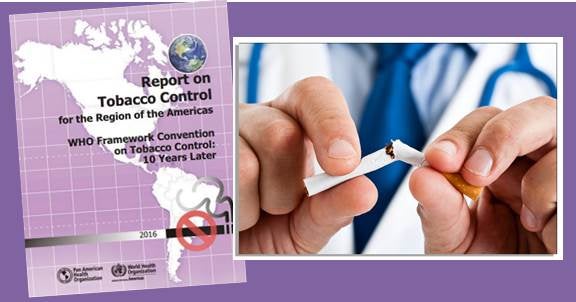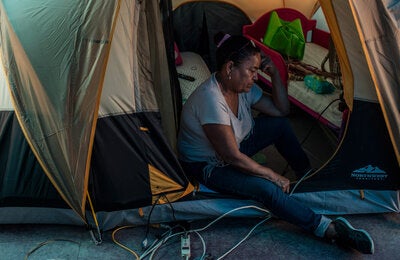

A number of countries of the Americas have made progress in implementing tobacco control policies designed to reduce suffering and death due to tobacco. Yet much remains to be done to halt the spread of a product that kills approximately a million people per year in the Region.

Ten years after the WHO Framework Convention on Tobacco Control took effect, a new PAHO report points to progress while highlighting the need to implement more of the treaty's measures to reduce tobacco use and save lives
Washington, D.C., 18 May 2016 (PAHO/WHO) — A number of countries of the Americas have made progress in implementing tobacco control policies designed to reduce suffering and death due to tobacco. Yet much remains to be done to halt the spread of a product that kills approximately a million people per year in the Region.
This is the conclusion of the new 2016 Report on Tobacco Control for the Region of the Americas, issued by the Pan American Health Organization (PAHO). The report provides the most up-to-date picture of the smoking epidemic in PAHO's 35 Member States 10 years after the WHO Framework Convention on Tobacco Control (FCTC) took effect.
According to the report, only half the population of the Americas (the inhabitants of 17 of 35 countries) is fully protected from the harmful effects of tobacco smoke by laws requiring smoke-free environments in all enclosed public places and workplaces and in the public transportation system.
The report also notes that large graphic warnings about the harmful effects of tobacco are mandatory in 16 countries (representing 58% of the population of the Americas), while only five countries (with 27% of the Region's population) prohibit tobacco advertising, promotion, and sponsorship, which are known to increase tobacco use, predominantly among adolescents and women.
Higher taxes on tobacco are the most effective strategy for reducing demand, since high prices encourage users to give up tobacco while discouraging others from starting to smoke. This, however, is the FCTC measure that has shown the least progress. Chile is the only country in the Region where taxes on cigarettes represent more than 75% of their retail sale price. Other countries—including Argentina, Jamaica, and Peru—have recently taken steps to increase taxation, though not as much as the 75% recommended by PAHO/WHO.
"It is imperative and urgent to protect all populations against the epidemic of tobacco-related diseases by fully implementing the measures set forth in the Framework Agreement," said the Director of PAHO/WHO, Carissa F. Etienne. "Only if we act today will we have a tobacco-free generation and save millions of lives."
Smoke-free spaces; large graphic health warnings; bans on tobacco advertising, promotion, and sponsorship; and increased taxes are the four FCTC measures designated by WHO as "best buys"—or highly cost-effective options—for reducing not only tobacco consumption but also the burden of noncommunicable diseases.
Tobacco use is responsible for some US$33 billion in costs to Latin America's health systems, which is equivalent to 0.5% of the region's collective gross domestic product (GDP). Taxes on cigarette sales currently cover less than half these costs.
Impact of smoking
Tobacco is responsible for an estimated 14% of deaths among adults over 30 in the Americas. Moreover, tobacco is the only risk factor common to the four main groups of noncommunicable diseases—cardiovascular disease, chronic respiratory disease, cancer, and diabetes—which are responsible for 80% of deaths in the Americas, 35% of which are considered premature, that is, before age 70.
There are 127 million smokers in the Americas. On average, 17% of the adult population consumes tobacco, although the report shows that prevalence varies across countries, ranging from 39% in Chile to 7% in Barbados and Panama (data for 2013).
Full implementation of the FCTC will help countries reach the global target of a 30% reduction in the prevalence of tobacco use among people over age 15 by 2025, and will contribute substantially to a 25% reduction in premature deaths due to noncommunicable diseases by the same year.
"In the 10 years since the treaty took effect, the Region of the Americas has advanced considerably, but we must not let down our guard," said Anselm Hennis, director of PAHO/WHO's Noncommunicable Diseases and Mental Health Department. "The signatory states have the obligation to continue to advance and to comply with the FCTC's mandates while addressing other challenges, including the introduction of new products such as the increasingly popular water pipes, and fighting continuing obstacles, such as strong interference from the tobacco industry."
In the Americas, 30 of the 35 PAHO/WHO Member States have ratified the FCTC, but implementation of the accord has been uneven. According to the report, only six countries in the Region have fully implemented four of the six demand-reduction measures—known as the MPOWER measures—and 11 signatory states have not yet implemented any of those measures.
The MPOWER measures include: monitoring tobacco use and prevention policies; protecting people from tobacco smoke; offering help to quit using tobacco; warning people about tobacco; enforcing bans on advertising, promotion, and sponsorship; and raising the price of tobacco.
The WHO FCTC has 180 signatories worldwide. It is the first legally binding international public health treaty developed under WHO auspices. The signatory parties are obligated to implement it fully, promulgating national legislation for reductions in both supply and demand. In 2012, the Conference of the Parties to the FCTC, which is the treaty's highest-level decision-making body, adopted the Protocol to Eliminate Illicit Trade in Tobacco Products, which constitutes a new international treaty in itself and is currently up for ratification. Three countries in the Americas——Ecuador, Nicaragua, and Uruguay——are parties to the Protocol, while a number of others have signed and are in the ratification process.
Implementation of the Framework Convention on Tobacco Control in the Americas
- 30 of 35 countries of the Americas have ratified the FCTC.
- 17 countries are totally smoke-free in public places and enclosed workplaces and in the public transportation system.
- 16 countries mandate graphic health warnings covering at least 50% of the main package surfaces, along with all of the features specified by the FCTC and its guidelines.
- 13 countries in the Americas have had tobacco taxes since 2012.
- 5 countries have completely banned all forms of tobacco advertising, promotion, and sponsorship.
- 8 countries offer assistance for quitting tobacco use, and provide a free telephone line, counseling, and cost-free nicotine replacement therapy.
- 3 countries have ratified the new Protocol to Eliminate Illicit Trade in Tobacco Products.
Links
— Regional Report on Tobacco Control, 2016
— WHO Framework Convention on Tobacco Control (FCTC)



